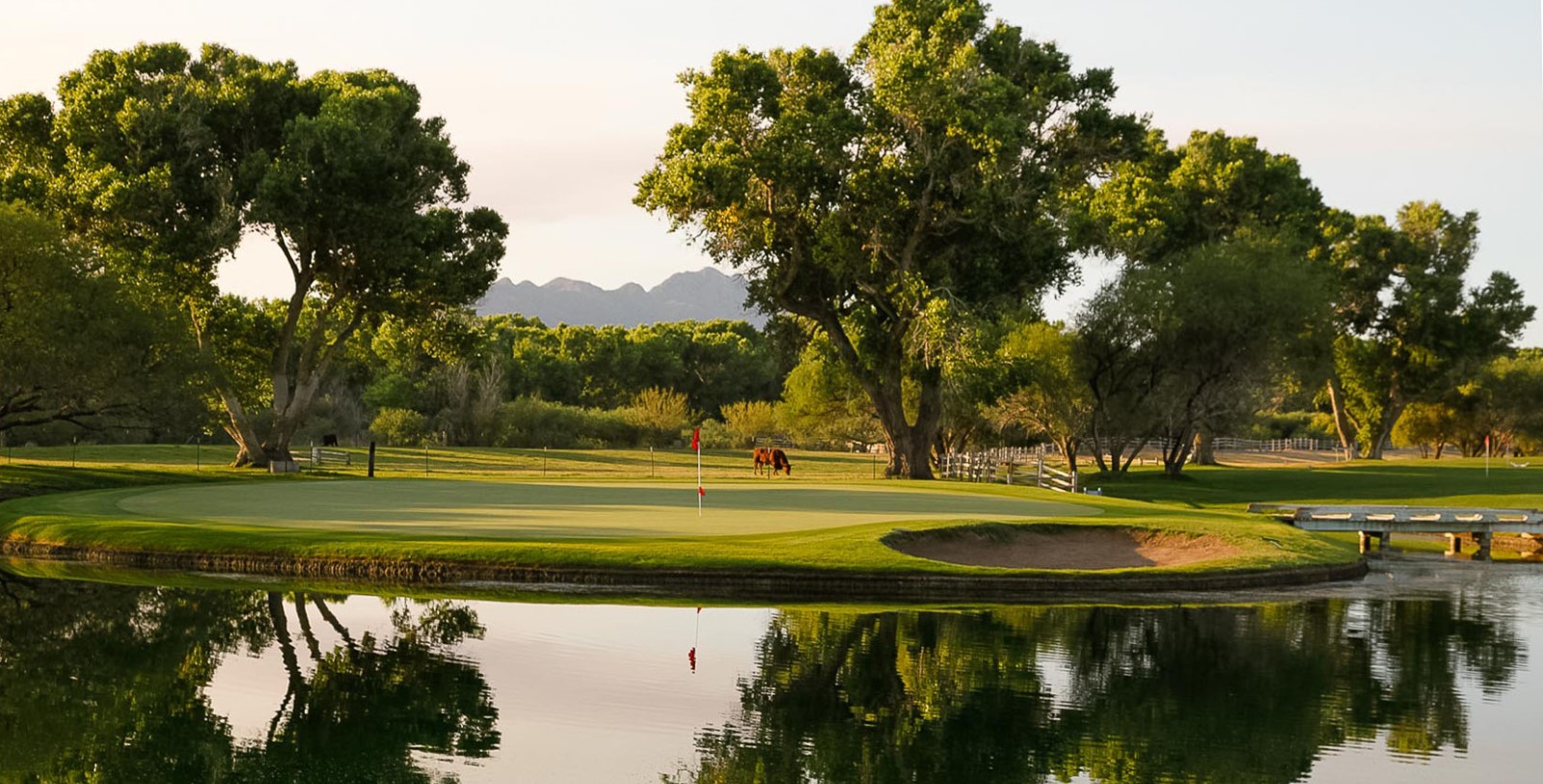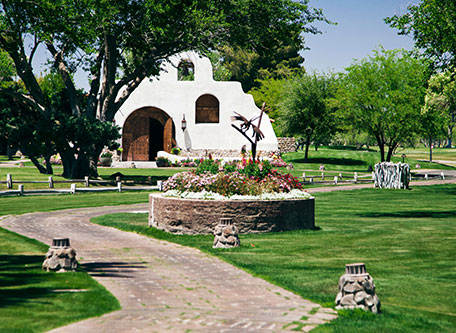Receive for Free - Discover & Explore eNewsletter monthly with advance notice of special offers, packages, and insider savings from 10% - 30% off Best Available Rates at selected hotels.
unwind and play at tubac golf resort
Discover the Tubac Golf Resort and Spa's three amazing golf courses: the Otero Couse, the Anza Course, and the Rancho Course.
Located along the Santa Cruz River, the Tubac Golf Resort and Spa opened in 1959 when a group of investors – including crooner Bing Crosby – purchased a historic Spanish-colonial ranch to be the site of a new luxury resort hotel. Called the “Tubac Golf Resort and Spa,” its first 18-hole golf course opened the same year. Set with a backdrop of the distant Santa Rita Mountains, the golf course itself still offers guests a unique, historic charm. The Santa Cruz River provides a surprisingly lush landscape, too, with plenty of ponds and tall cottonwood trees to observe. Indeed, its inherent beauty was even recognized in the celebrated romantic comedy, Tin Cup. The first nine holes were designed by renowned golf course architect Robert “Red” Lawrence. That original course—the Otero Course—is still celebrated today as one of the top golf courses in Tubac, AZ, known for its beauty and historic design. Red himself was quite accomplished at the time, having helped found the American Society of Golf Course Architects in 1946. (The Otero Course was later expanded to feature a full complement of 18 fairways several years later.) Then in 2006, the resort expanded to 36 holes after local golf course architect Ken Kavanaugh installed additional fairways that enhanced the course’s already beloved layout. Eighteen of those holes were transformed into two distinct nine-hole courses: the Anza and the Rancho. Together with the historic Otero Course, the Anza and Rancho courses helped solidify the Tubac Golf Resort and Spa’s status as a preeminent destination for all avid golfers regardless of their skill level.
The Anza Course—named after Juan Baptist DeAnza, the commandant of the Tubac Presidio—featured captivating mountain views and challenging greens. It also ended climactically at the famous par-three island green in front of the Stables Patio Bar. Meanwhile, the Rancho Course was set along the banks of the Santa Cruz River. Unlike any other golf setting in southern Arizona, the course’s mesquite Bosques and cottonwood trees created a serene atmosphere that enchanted all its players. Several of the holes on each course are particularly regarded for their beautiful design. On Otero Nine, water guarded the entire left side of this par-four hole, which looked back at the Chapel. The Anza Nine served as the resort’s magnificent, yet intimidating, island green. The par-three hole was also reminiscent of the 17th at TPC Sawgrass, save for the cattle. Finally, Rancho Four, was a gorgeous par-five shot. The pond fronting the green prevented all but the longest hitters from getting “home” in two. In fact, it was this hole that acted as the setting for the scene in Tin Cup, where Kevin Costner was caddying for Don Johnson, and Johnson wanted to lay up with a seven iron. Today, the resort invites locals and travelers to play its three desert oasis courses. The design allows golfers to choose two nine-hole courses for an 18-hole game that creates all sorts of special golfing experiences. The Tubac Golf Resort and Spa also offers its golf enthusiast shopping opportunities at its golf shop and private instruction with on-staff PGA professionals. Few places can truly rival the historic golfing heritage that still defines the Tubac Golf Resort and Spa today.
-
About the Location +
The small community of Tubac has an ancient history, hailing back to a small Spanish fortress, known at the time as a “presidio.” Developed in 1725, it functioned as Spain’s first colonial garrison in what is now Arizona. The tiny frontier outpost grew to become a significant stop along the Camino Real, which connected the provinces of New Spain (Mexico) with those of Alta California. Eventually, Lieutenant Colonel Juan Bautista de Anza briefly moved to the fort, living within the facility from 1760 to 1776. He was ultimately responsible for founding the El Presidio Real de San Francisco just outside of the Mission San Francisco de Asis. Yet, Anza spent most of his time at the Tubac presidio, before venturing north to create its more famous cousin in California. He specifically constructed a chapel called “Santa Gertudis,” the foundations of which currently reside under the newer St. Ann’s Church. The fort then gradually found itself defending against a series of vicious Apache attacks throughout the early 1800s, who had started to resist the encroachments of Spanish—and later Mexican—settlers onto the land. The climax of those raids occurred during the 1840s, forcing the garrison and its population of civilian workers to briefly vacate the premises. American troops soon controlled Tubac though, following their seizure of the territory during the Mexican-American War. But the Apache attacks continued well into the mid-19th century, culminating with a four-day siege in 1861. Peace finally arrived to the region by the dawn of the 20th century, in which Tubac became a vibrant art colony. Today, Tubac, Arizona, is now a fascinating tourist destination, thanks in large part to the magnificence of the Tubac Golf Resort and Spa.
-
About the Architect +
Robert Lawrence: Affectionately remembered to history as “Red,” Robert Lawrence was a prominent golf course architect whose work largely appeared in the American Southwest. His career began as a landscaper with the Westchester Country Club in 1919. Spending only a few years at Westchester, Lawrence eventually found work with the renowned architectural firm Toomey and Flynn during the Roaring Twenties. Lawrence specifically became an acolyte of William S. Flynn, serving as one of his construction superintendents. He even helped Flynn finish many important projects, like the development of the Merion Golf Club and The Cascades at The Omni Homestead Resort (another member of Historic Hotels of America.) But when the Great Depression befell the nation, Lawrence unfortunately had to leave his job with Toomey and Flynn. Moving to Boca Raton in Florida, he subsequently did golf course maintenance over the next two decades. Nevertheless, Lawrence’s influence remained strong throughout the sport of golf. Indeed, he even rose to become one of the founding members to the American Society of Golf Course Architects in 1946. Around the same time, Lawrence relocated to Arizona, where he began constructing golf courses again. His brilliant use of the local topography in his designs quickly earned him another moniker among his fellow contemporaries—the “Desert Fox.” Among the most noteworthy courses that Lawrence created while living in Arizona included the Desert Forest Golf Club, the Tubac Golf Resort and Spa’s Otero Course, and the Championship Golf Course at the University of New Mexico. Since his death in 1976, Lawrence’s designs have gained significant praise throughout the United States. In fact, Lawrence was inducted posthumously into the Arizona Golf Hall of Fame due to his accomplishments in 2003.
-
Famous Historic Golfers +
Bing Crosby, singer and actor known for his roles in Going My Way and The Bells of St. Mary’s.
-
Film, TV and Media Connections +
Tin Cup (1996)
































